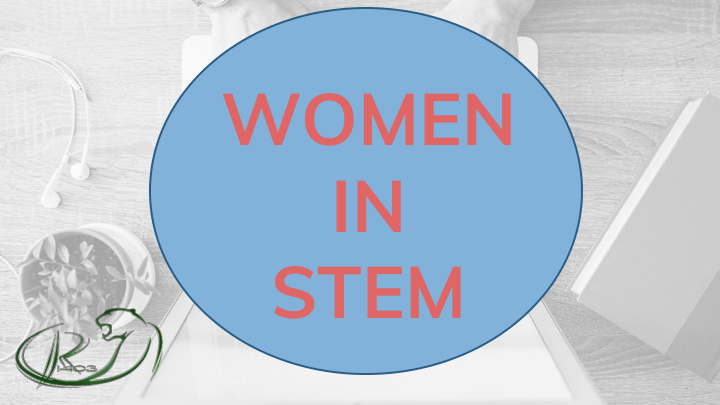



WOMEN IN STEM
Discussion Question: Has there ever been a moment in your life that you felt discriminated? How did you react?
Statistics ● In the United States, around 50% of women make up the college-educated workforce while only 29% of the science and engineering workforce. NSF, Science & Engineering Indicators, 2016 ● The percent of female scientists in fields in the social sciences (62%) are much more than the percentage of females in engineering (15%) and computer and mathematical sciences (25%). NSF, Science & Engineering Indicators, 2016
● Women with a STEM degree are less likely than their male counterparts to work in a STEM occupation; they are more likely to work in education or healthcare. NSF, Women, Minorities, and People with Disabilities in Science and Engineering, 2015 ● While women receive over half of the bachelor’s degrees awarded in the biological sciences, only 17.9% of women receive bachelor’s degrees in the computer sciences and only 19.3% receive them in engineering. NSF, Science & Engineering Indicators, 2016
40% Minorities in STEM Women of color in astronomy of women of color had feelings of being unsafe in the and planetary science face workplace due to their gender or more gender and race related sex . 28% hostile environments, according to a study published in the Journal of Geophysical of women of color felt unsafe due to Research: Planets by the their race. 18% American Geophysical Union. Clancy, Kathryn B. H., et al. “Double Jeopardy in of women of color skipped Astronomy and Planetary Science: Women of Color Face Greater Risks of Gendered and Racial professional events out of concern of Harassment.” Journal of Geophysical Research: Planets , Journal of Geophysical Research, 10 July 2017, their safety. onlinelibrary.wiley.com/doi/10.1002/2017JE005256/full.
Discussion Question: Why are there so few women in STEM fields?
Why So Few? ● Lack of ● Stereotypes Confidence ● Mentorship ● Female Interest ● Lack of ● Harassment Support ● Discrimination ● Lack of Role Models
“I’m simply stating, that the distribution of preferences and abilities of men and women differ in part due to biological causes and that these differences may explain why we don’t see equal representation of women in tech and leadership.” James Damore, former Google engineer
Discussion Question: How did you feel about reading this quote?
Stereotypes The common stereotype for a person in a ● science field is someone who is male. Because women do not fit into that mindset, they are unfairly penalized because of it. “ Women do not possess the required skills that ● men inherently possess for certain professions or job titles” . A more general stereotype that still relates to STEM fields is that women are not fit to lead well and manage employees like men do. This leads to an underrepresentation of women in leadership roles. Hill, Catherine. “Why So Few? Women in Science, Technology, Engineering, and Mathematics.” AAUW: Empowering Women Since 1881 , 2010, www.aauw.org/research/why-so-few/.
Another common stereotype is that “science is not feminine”. From a young age, women are conditioned to have domestic aspirations such as being pretty, desirable, and becoming a great wife/mother. STEM-related job fields are seen more “masculine” by nature and young girls who excel in these fields are labeled as unfeminine. Hill, Catherine. “Why So Few? Women in Science, Technology, Engineering, and Mathematics.” AAUW: Empowering Women Since 1881 , 2010, www.aauw.org/research/why-so-few/.
They had male and female scientists at a research university wear audio recorders and go about their work. When the scientists analyzed the audio samples, they found there was a pattern in the way the male and female professors talked to one another. When male scientists talked to other scientists about their research, it energized them. But it was the opposite for women, specifically in their conversations with male colleagues. Vedantam, Shankar. “How Stereotypes Can Drive Women To Quit Science.” NPR , NPR, 12 July 2012, www.npr.org/2012/07/12/156664337/stereotype-threat-why-women- quit-science-jobs.
Stereotype Threat Claude Steele, a provost at the University of California, Berkeley, said that when there's a stereotype in the air and people are worried they might confirm the stereotype by performing poorly, their fears can inadvertently make the stereotype become self-fulfilling.
Discussion Question: How should we go about challenging stereotypes about women in STEM
Discrimination In a study conducted in 2012, the science faculty at a university were sent the materials of students who were applying for a lab manager position at their university. The materials were the same for each student but each student was assigned a random male or female name. Moss- Racusin, Corinne A., et al. “Science Faculty’s Subtle Gender Biases Favor Male Students.” Proceedings of the National Academy of Sciences of the United States of America , National Academy of Sciences, 9 Oct. 2012, www.ncbi.nlm.nih.gov/pmc/articles/PMC3478626/ .
The researchers found that the science faculty rated the male students as more competent and hireable than the female students, though the applications were identical. This is just one study that proves that if individuals are given information about the gender of a person or candidate, they will use their prior knowledge such as stereotypes to categorize each candidate. Hill, Catherine. “Why So Few? Women in Science, Technology, Engineering, and Mathematics.” AAUW: Empowering Women Since 1881 , 2010, www.aauw.org/research/why-so-few/.
Speakers: Ms. Fiona Borland Director of Instructional Technology of Montgomery High School Ms. Shruti Das Computer Engineering University of Maryland
Discussion Question: How should we go about introducing more women into STEM related fields and supporting them through their endeavors?
Recommend
More recommend